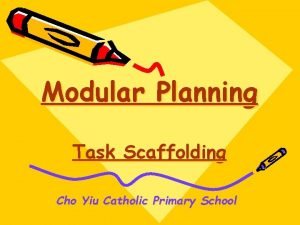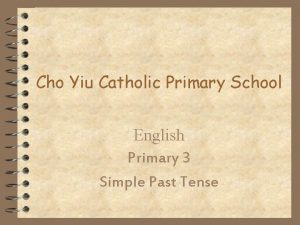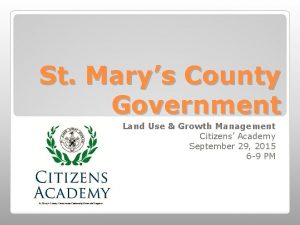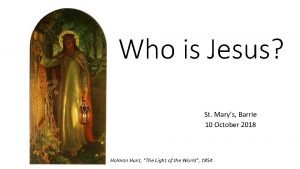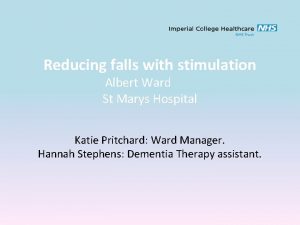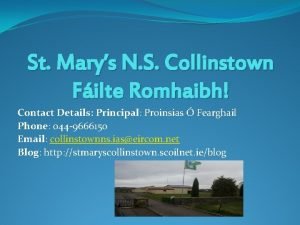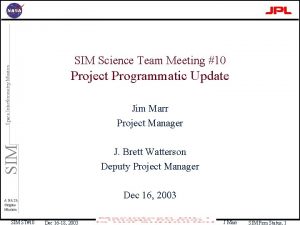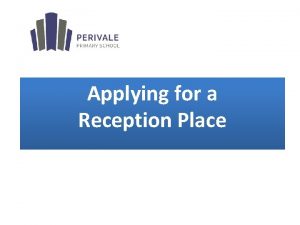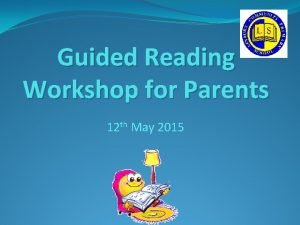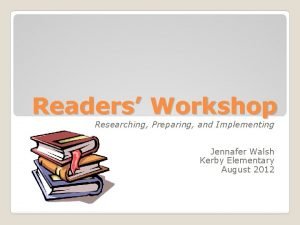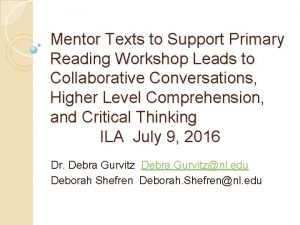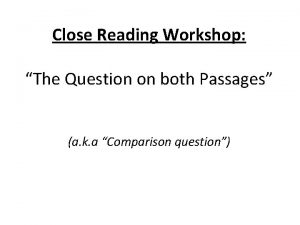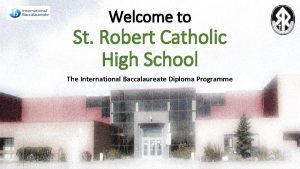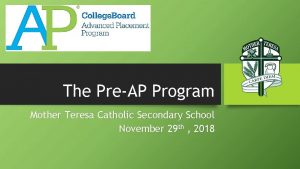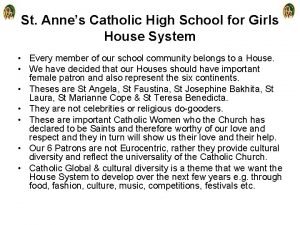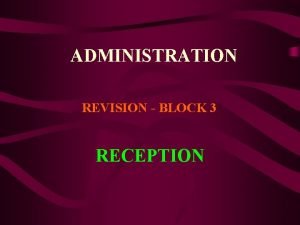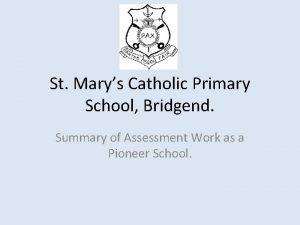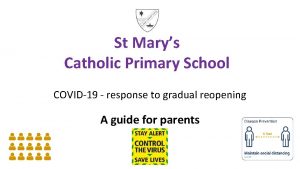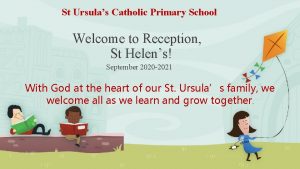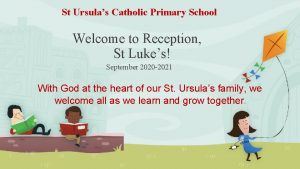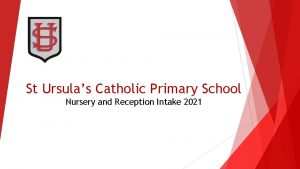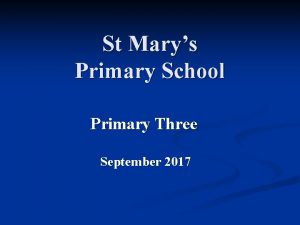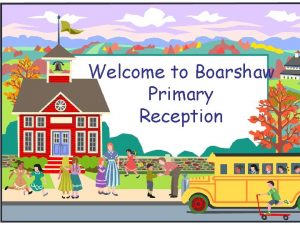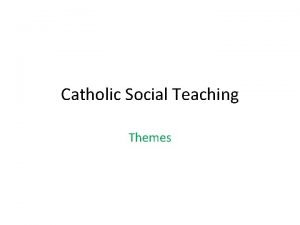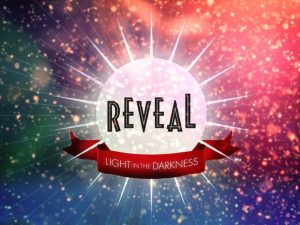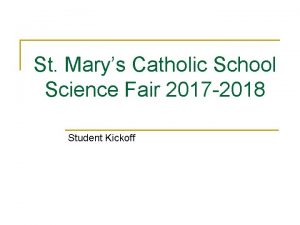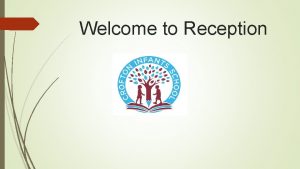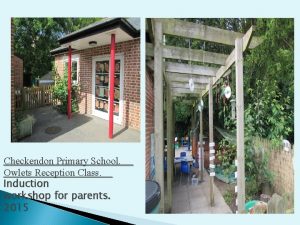St Marys Catholic Primary School Reception Reading Workshop























- Slides: 23

St Mary’s Catholic Primary School Reception Reading Workshop 2016/17

Aims • How you can hep your child with Early reading skills. • Have a greater understanding of how Literacy is promoted in the Early Years. Share with your child some of the activities we promote in class.

EYFS Expectations

• 30 -50 MONTHS • Enjoys rhyming and rhythmic activities. • Describes main story settings, events and principal characters. • Shows interest in illustrations and print in books and print in the environment. • Shows awareness of rhyme and alliteration. • • • Recognises familiar words and signs such as own name and advertising logos. • Looks at books independently. • Handles books carefully. Recognises rhythm in spoken words. Listens to and joins in with stories and poems, one-toone and also in small groups. • Joins in with repeated refrains and anticipates key events and phrases in rhymes and stories. • Knows information can be relayed in the form of print. • Beginning to be aware of the way stories are structured. • Holds books the correct way up and turns pages. • Suggests how the story might end. • Knows that print carries meaning and, in English, is read from left to right. • Listens to stories with increasing attention and recall.

40 -60 MONTHS - End of Reception • Continues a rhyming string. • Hears and says the initial sound in words. • Can segment the sounds in simple words and blend them together and knows which letters represent some of them. • Links sounds to letters, naming and sounding the letters of the alphabet. • Begins to read words and simple sentences. • Uses vocabulary and forms of speech that are increasingly influenced by their experiences of books. • Enjoys an increasing range of books. • Knows that information can be retrieved from books and computers. • Early Learning Goal • Children read and understand simple sentences. • They use phonic knowledge to decode regular words and read them aloud accurately. • They also read some common irregular words. • They demonstrate understanding when talking with others about what they have read.

Before children can learn to read and write they need to develop their understanding of the English language. For all of us this happens through talk. Through talk we learn new vocabulary and the knowledge of how to structure sentences. In school we encourage the children to talk in a variety of situations. Conversation is a good starting place!

Three aspects of reading • whole word • - prediction • – picture • – grammar • – story • phonics • beginner readers will be practising one or more of these aspects until all three are used

Understanding • It is not just about knowing words understanding and comprehension is vital. • Children need to share with you what they understand about what they have read. • They need to predict what could happen next. • They need to be able to read between the lines.

5 finger retelling Comprehension is crucial!! Questions: • What happened at the beginning of the story? • Who are the main characters? • What was the problem they needed to solve? • What happened in the story? • (Ask about beginning, middle, and end) • How did they solve the problem?

Goldilocks and the three bears • Retell the story Predict what would Goldilocks do? • Between the lines – why was Baby Bear sad?

Reading in the environment • Not all reading is in books • Surrounded by print that communicates a message. Alert your child to uses of print in the environment • Point out signs and labels



• Supporting your child at home • Have fun with books. • Visit the library • Focus on letter sounds. • Choose books that are interesting to your child • Provide a comfortable area for reading enjoyment • Set a routine time for reading that’s not assigned, e. g. . at bed time or after dinner. • Reading Games e. g. eye spy, rhyming games etc • Develop an awareness of holding a book, turning pages, reading left to right.

Reading in the FS • Your child will read twice per week. You will be given set days to do this. It is important that reading records are signed by an adult at home. • Each time your child reads they will go over the High Frequency Words (HFW) These are the most common 45 words in Reception. We will only move on with these words when your child is confident • (*we ask them the words in random order as children have great memories!)

Phonics • We use a mixture of Jolly phonics and Letters and sounds • We encourage the children to know the name, sound, action and how to write. • Once these are developed we move onto blending and segmenting CVC words cat – c-a-t

Reading records Library books

I cnduo't bvleiee taht I culod aulaclty uesdtannrd waht I was rdnaieg. Unisg the icndeblire pweor of the hmuan mnid, aocdcrnig to rseecrah at Cmabrigde Uinervtisy, it dseno't mttaer in waht oderr the lterets in a wrod are, the olny irpoamtnt tihng is taht the frsit and lsat ltteer be in the rhgit pclae. The rset can be a taotl mses and you can sitll raed it whoutit a pboerlm. Tihs is bucseae the huamn mnid deos not raed ervey ltteer by istlef, but the wrod as a wlohe. Aaznmig, huh?





Activities
 Pope paul catholic primary school
Pope paul catholic primary school Maßshirts
Maßshirts Cho yiu catholic primary school
Cho yiu catholic primary school Cho yiu catholic primary school
Cho yiu catholic primary school St mary's county land use and growth management
St mary's county land use and growth management St marys barrie
St marys barrie St marys college arklow
St marys college arklow Victoria and albert ward st mary's hospital
Victoria and albert ward st mary's hospital St mary's collinstown
St mary's collinstown Simspace st marys
Simspace st marys Marys river
Marys river St marys
St marys While reading activities
While reading activities Applying reception school
Applying reception school Reading workshop for parents
Reading workshop for parents Pros and cons of reading workshop
Pros and cons of reading workshop Mentor texts for reading workshop
Mentor texts for reading workshop Identify a key term used in both passages.
Identify a key term used in both passages. Japanese school uniforms history
Japanese school uniforms history St. robert catholic high school boundary
St. robert catholic high school boundary Mother teresa catholic secondary school
Mother teresa catholic secondary school St annes high school for girls
St annes high school for girls St ann catholic church arlington va
St ann catholic church arlington va Lau ka lun
Lau ka lun


